How Many Wing Feathers Does a Sparrow Have: A Step-by-Step Guide
A sparrow typically has a total of 18 to 20 primary wing feathers. These feathers play an essential role in providing thrust and aiding in agile flight maneuvers.
Additionally, sparrows possess 9 to 10 secondary feathers that contribute to lift and stability, as well as 2 to 5 tertiary feathers that support wing structure and minimize turbulence. These feathers are intricately arranged to optimize the bird's aerodynamic efficiency, allowing for quick and agile movement through dense vegetation.
For a deeper understanding of sparrow wing feather functionality and their role in flight dynamics, further details follow.
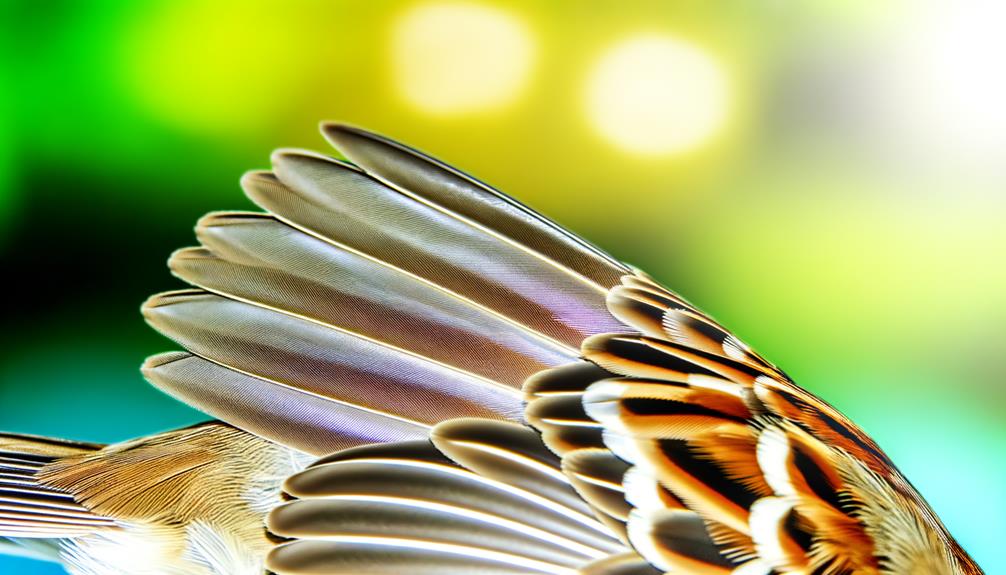
Key Takeaways
- Sparrows typically have ten primary wing feathers on each wing.
- Sparrow wings consist of nine to ten secondary feathers.
- Tertiary feathers in sparrows number between 2-5 per wing.
- Sparrows possess a total of around 18-20 main wing feathers.
- The primary feathers provide thrust, while secondaries enhance lift and tertiaries support structure.
Sparrow Wing Anatomy
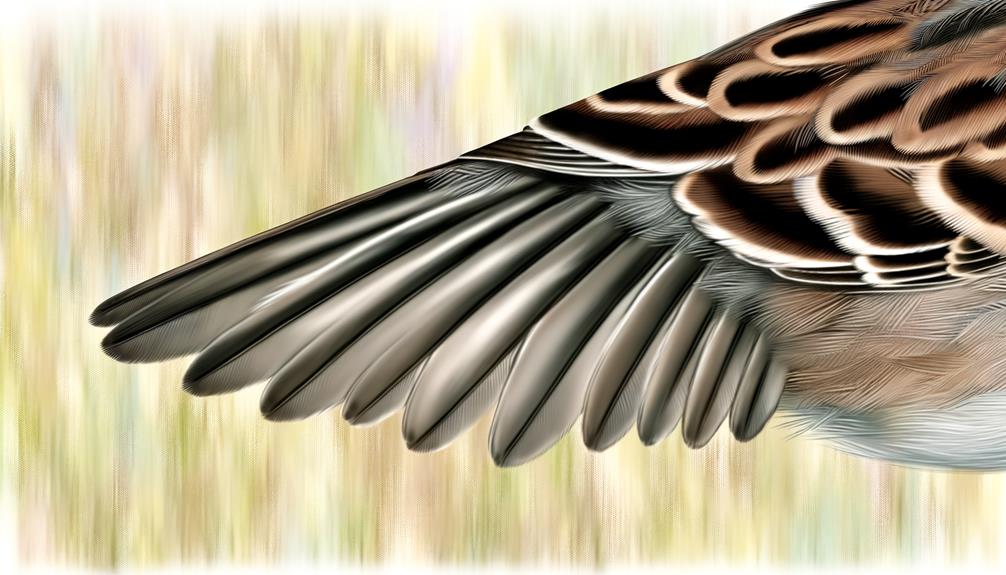
How does the intricate structure of a sparrow's wing provide the functionality needed for flight?
The sparrow's wing anatomy is a marvel of evolutionary engineering, designed to optimize both lift and maneuverability. The skeletal framework, composed primarily of the humerus, radius, and ulna, offers a lightweight yet robust support system.
Muscles such as the pectoralis major and supracoracoideus facilitate powerful downstrokes and efficient upstrokes. Additionally, the wing's aerodynamic shape, characterized by a convex upper surface and concave lower surface, enables the generation of lift.
The arrangement of primary, secondary, and tertiary feathers further contributes to aerodynamic efficiency, reducing drag and enhancing thrust. This anatomical complexity ensures the sparrow's proficiency in agile, sustained flight, vital for foraging and evasion from predators.
Types of Wing Feathers
Wing feathers in sparrows are categorized into three primary types: primaries, secondaries, and tertiaries, each serving distinct aerodynamic and functional roles essential for flight.
Primaries are the outermost feathers attached to the manus, responsible for generating thrust during flight. Their asymmetrical shape enhances aerodynamic efficiency.
Secondaries, attached to the ulna, contribute to lift and aid in maintaining stable flight. They are symmetrically shaped and form the airfoil's surface.
Tertiaries, located closest to the body on the humerus, support the wing's structural integrity and assist in maneuverability.
Detailed ornithological studies have documented these distinctions, underscoring the complexity and specialization of avian wing morphology in sparrows, which is vital for their survival and ecological adaptation.
Primary Feathers Count
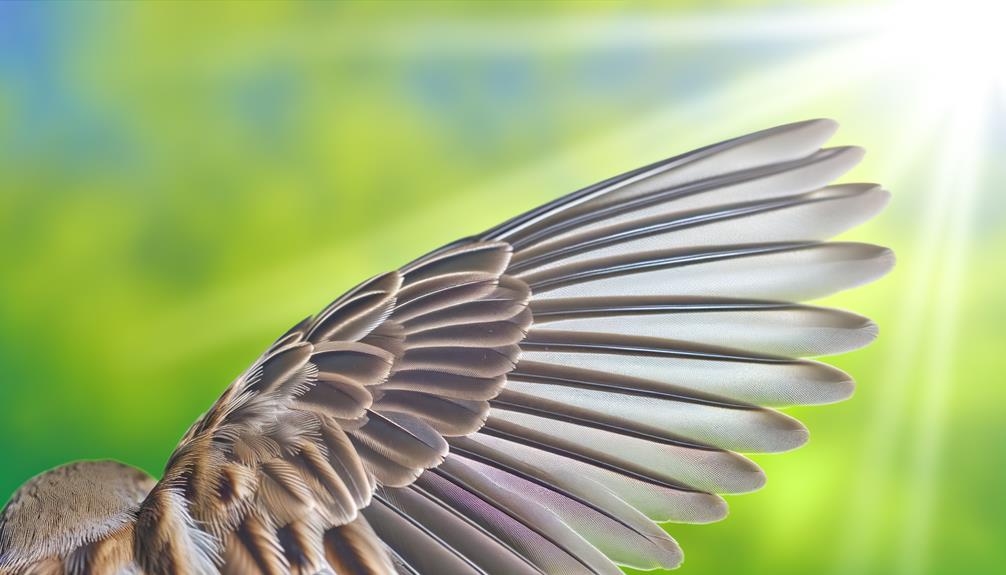
Sparrows typically possess ten main feathers on each wing, a characteristic feature that plays an important role in their flight mechanics and overall aerodynamics.
These main feathers, also known as remiges, are the longest and most strong feathers, primarily responsible for generating lift and thrust during flight. Detailed observations have shown that their asymmetrical shape is vital for minimizing air resistance and maximizing flight efficiency.
Ornithological studies confirm that the precise arrangement and condition of these feathers greatly influence a sparrow's ability to maneuver, accelerate, and maintain steady flight. The strength of main feathers guarantees structural integrity, aiding in sustained flapping and gliding.
Understanding these dynamics is crucial for comprehending avian flight and the evolutionary adaptations that enable sparrows to navigate complex aerial environments.
Secondary Feathers Count
In addition to their primary feathers, sparrows possess a series of secondary feathers that contribute notably to their aerodynamic capabilities and flight stability. Typically, a sparrow's wing comprises nine to ten secondary feathers, which are attached to the ulna bone in the bird's wing.
These feathers play a pivotal role in enhancing lift and enabling more controlled, refined maneuvers during flight. Detailed ornithological studies have shown that secondary feathers are essential for maintaining balance and precision, particularly during slower flight and landing phases.
Researchers have observed that the condition and arrangement of these feathers can significantly impact a sparrow's flight efficiency, highlighting their importance in avian physiology and flight dynamics.
Tertiary Feathers Overview
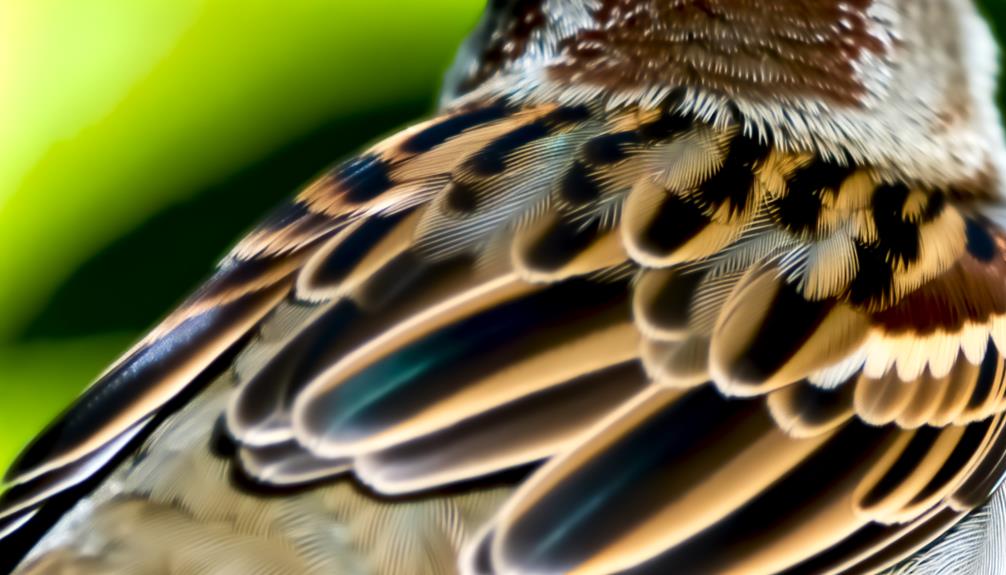
Tertiary feathers, located proximally on the sparrow's wing, serve as important elements for maintaining aerodynamic efficiency and stability during complex flight maneuvers. These feathers, numbering typically between 2-5, are situated closest to the bird's body, nestled between the secondary feathers and the bird's flank.
Observations indicate that tertiary feathers play a key role in minimizing turbulence and streamlining airflow over the wing structure. Their positioning and structural integrity have been examined through high-speed videography and computational fluid dynamics, confirming their significance in enhancing flight performance.
The precise alignment and overlap of these feathers are essential in supporting the bird's agility and precision, particularly during rapid directional changes and hovering. This configuration underscores their necessary role in avian flight dynamics.
Feather Functions
The intricate functions of wing feathers encompass a variety of roles crucial to the sparrow's flight dynamics, including lift generation, maneuverability, and thermal regulation. Each feather type contributes uniquely to these essential functions.
- Primary Feathers: These feathers, located at the wing tips, are crucial for thrust and lift. They enable high-speed flight and assist in agile directional changes.
- Secondary Feathers: Positioned along the wing's trailing edge, secondary feathers maintain lift and contribute to the bird's overall flight stability.
- Coverts: These smaller feathers overlay the primary and secondary feathers, reducing turbulence and improving aerodynamic efficiency.
Detailed observation reveals that the synergy between these feather types ensures excellent flight performance, facilitating the sparrow's survival and ecological success.
Molting Process
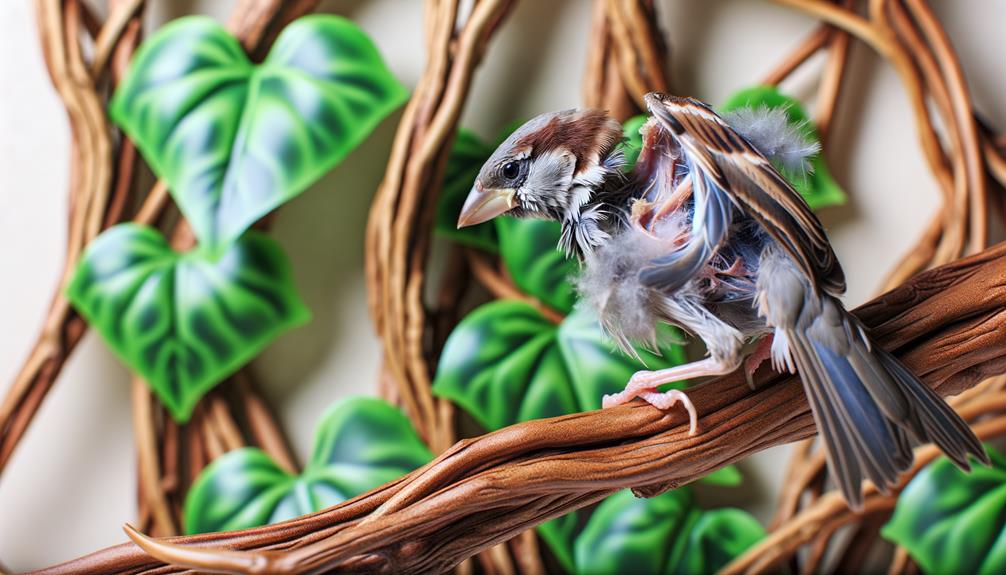
During the molting process, sparrows systematically shed and regrow their wing feathers to maintain best flight capabilities and feather health.
Molting typically occurs once or twice a year, influenced by factors such as age, season, and environmental conditions.
The process is sequential, ensuring that the bird never loses too many feathers at once, which could impair flight.
Initial feather loss begins with the primary feathers, followed by the secondaries. New feathers, or pin feathers, emerge from follicles, gradually replacing the old ones.
This regrowth is essential for ideal aerodynamics, insulation, and protection.
Empirical studies indicate that molting duration can vary, generally lasting several weeks to months, ensuring the sparrow remains in peak condition for survival and reproduction.
Comparison With Other Birds
When comparing the wing feathers of sparrows to those of finches and robins, distinct morphological differences become evident. Sparrows exhibit relatively shorter and rounder wing feathers, which are adapted for agile, short-distance flights, whereas finches possess more elongated feathers suited for sustained flight.
In contrast, robins display a combination of rounded and elongated feathers, providing a balance between maneuverability and endurance.
Sparrow Vs. Finch Feathers
Comparing sparrow and finch feathers reveals distinct morphological differences that are crucial for their respective flight mechanics and ecological adaptations. These differences are mainly observable in the size, structure, and density of the feathers.
- Feather Length: Sparrow wing feathers are usually shorter, enhancing maneuverability in dense vegetation, while finch feathers are longer, assisting in sustained flight.
- Feather Structure: Sparrows have more rigid feather shafts, offering greater stability during rapid directional changes. Finches, on the other hand, display more flexible shafts, which optimize aerodynamic efficiency.
- Feather Density: The feather density in sparrows is higher, contributing to increased insulation and energy conservation. Finches have a relatively lower feather density, reducing weight and consequently minimizing energy expenditure during flight.
These variations emphasize the unique evolutionary pressures faced by each species.
Sparrow Vs. Robin Feathers
An analysis of sparrow and robin feathers reveals significant differences in their morphological characteristics, which are reflective of their distinct ecological niches and flight behaviors.
Sparrows, typically smaller with more rounded wings, possess approximately 18-20 primary wing feathers, optimized for agile, quick flights within dense vegetation.
Robins, larger in size, exhibit elongated, more pointed wings with 10 primary wing feathers, facilitating sustained, direct flights across open spaces.
The primary feather structure in robins shows a higher degree of asymmetry, enhancing aerodynamic efficiency. Conversely, sparrow feathers display less pronounced asymmetry, supporting rapid maneuverability.
These morphological distinctions underscore the evolutionary adaptations each species has undergone to optimize their survival and efficiency within their respective habitats.
Conclusion
To sum up, sparrows possess a total of 19 wing feathers, which include 9 primary feathers and 10 secondary feathers, supplemented by additional tertiary feathers.
An interesting statistic is that these feathers undergo a molting process annually, which enhances flight efficiency and adaptability.
This precise feather arrangement and molting cycle demonstrate the intricate evolutionary adaptations that improve a sparrow's survival and functionality, offering insights into avian morphology and comparative anatomy across bird species.






